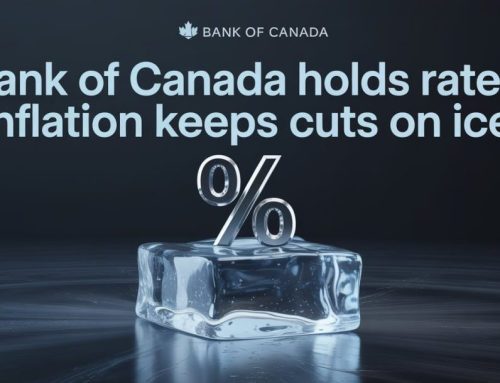While the Bank of Canada has eight scheduled rate announcements per year, fixed mortgage rates have no set schedule. They can move in either direction at any time, and one piece of news can put severe pressure on them in one direction or another.
Most recently, there was news of inflation increasing to 4.4% year over year in April, which was the first increase since it peaked at 8.1% in June 2022.
One of the biggest influencers in the direction of fixed mortgage rates are bond yields. They were already rising steeply before the release of April’s inflation numbers. The news fuelled the fire, pushing the bond yields up even higher. The result was an increase in fixed mortgage rates by as much as 0.35% with some lenders.
But will rates continue to rise? And does this mean that we could see another increase from the Bank of Canada?
Upward Pressure on Fixed Mortgage Rates
A lender’s profit margin on fixed rate mortgages will shrink when bond yields rise. This is why we saw the majority of the lower rate lenders increase their rates at the end of last week. When bond yields rise, rate increases are required for the lender to remain profitable.
The recent upward trend in bond yields has been steep. This is an indication that the yields could rise further, which would mean more increases to fixed mortgage rates.
Will the Bank of Canada Increase Their Rate Further?
In their March 8th rate announcement, the Bank of Canada stated that they are pausing their rate hikes. Note the wording here. It’s not necessarily a stop, but a pause. They also indicated that they are prepared to increase their rate further if needed.
It was widely expected that the 0.25% increase we saw on March 8th would be the last in this cycle. But circumstances can and do change, and there is still a great deal of economic uncertainty. Inflation has become a big problem which the Bank of Canada has been desperately trying to get under control.
This is why they had to be so aggressive in the first place. It won’t matter if mortgage rates are low if the cost of everything else gets out of control.
With April’s inflation numbers increasing for the first time since June 2022, some are starting to speculate that we could see another increase from the BoC on June 7th, their next scheduled announcement date.
But what are the chances of another hike?
Forecasts from the Big Six Banks
Two of the big banks have updated their forecasts following the release of April’s inflation data on May 16th.
BMO updated their economic outlook on May 19th, leaving their previous forecast unchanged. They don’t expect any further rate hikes and anticipate the first rate cut to be in the first quarter of 2024.
On the other hand, Scotiabank was not as optimistic. They were originally not expecting any further increases in this cycle. But they updated their economic forecast on May 18th and are now expecting a 0.25% rate hike on June 7th. They are still forecasting for the BoC to start cutting their rate in the first quarter of 2024 with a total of 1.50% in rate cuts by the end of next year.
The other four of the big six banks have not yet updated their forecasts, which all reflect no further increases in 2023 and with cuts to start in the first quarter next year. The exception is National Bank, who is forecasting for the first cut to be in the fourth quarter of this year.
It will be interesting to see if the other banks make any forecasting adjustments, but we’ll likely have to wait until next month when they are expected to release their updated reports. Stay tuned to future blogs where I’ll continue providing updated information as it’s released.
Rate Cuts from the Bank of Canada
We know that the BoC will eventually start to cut rates, which they don’t expect to happen before 2024. This outlook has not changed much since last summer. Following the collapse of Silicon Valley Bank in March, some were speculating that we could see the BoC cut their rate much sooner, possibly as early as June. These forecasts are now non-existent, and the chances of a rate cut this year now appear to be slim.
The Bank of Canada has made it clear on multiple occasions that they will not cut their rate until they reach their inflation goal of 2%. They are expecting to reach this target by the end of 2024. If we listen to them, then that would mean waiting until the end of next year before we see the first rate cut.
But will we need to wait that long?
Given that they were radically wrong in their early 2022 forecasts, they are more likely to err on the side of caution. They don’t want to get anyone’s hopes up only to be proven wrong yet again. There is still a lot of uncertainty, which they are well aware of.
What Can We Expect from Inflation?
Whenever something unexpected happens in the financial world, it can shock the system which can create a market reaction. In this case, the April inflation numbers were expected to come in at 4.1%, yet the actual number ended up being 4.3%. While this doesn’t sound like a big difference, it was the first shift in trend since June 2022, which resulted in the bond market reacting with a sharp, upward spike.
But is the market overreacting in this case?
That wouldn’t be surprising, as a market overreaction is not uncommon.
Economists, along with the Bank of Canada, will be anxiously watching for the release of the inflation numbers for May, which are not expected until June 27th.
The next scheduled rate announcement from the BoC is 20 days earlier on June 7th, which means they will need to decide based on speculation. If they are particularly concerned about inflation, then this could mean another 0.25% rate hike on that date.
My professional opinion is that they will continue with their rate pause. While in a perfect world, the rate of inflation will continue to drop each month until it stops at the 2.00% goal. But an uninterrupted downward trend in inflation may not be a realistic expectation. Even the best producing stocks will see ups and downs along the way.
When BMO Economics updated their forecast on May 19th, they stated that “it’s almost certain that headline inflation will take a mighty step down next month – possibly by a full percentage point to the low 3s”.
Their confidence is certainly promising!
This is an indication that the market overreacted to April’s inflation numbers. If this proves to be true, then we can likely expect to see bond yields settle, which would then relieve upward pressure on fixed mortgage rates.
You can read BMO’s full comments in their blog which is humorously named “It Ain’t Over ‘til the Fat Core Slims”.
Conclusion
There are always going to be different opinions. Some people will make you think the sky is falling. This alone can be enough to send anyone into panic mode. Always take into consideration who the information is coming from, and always check out other opinions as well. The truth is that no one knows for sure. Circumstances and forecasts can change. They have changed before and will change again. Time will tell and anything can happen.
For now, we must take the rising bond yields seriously, which are up another 1.93% today (at the time of writing). If they continue rising, then it is certain that we’ll see fixed mortgage rates increase with them.
Anyone with a mortgage renewal, or purchase closing within the next 120 days should get a rate locked in ASAP. Contact us today to find out the lowest rate available for your situation.








Leave A Comment